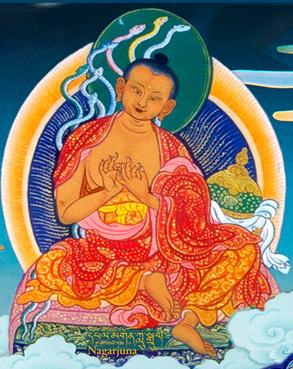Nagarjuna: Difference between revisions
No edit summary |
mNo edit summary |
||
| Line 16: | Line 16: | ||
*[[Collection of Middle Way Reasoning]] | *[[Collection of Middle Way Reasoning]] | ||
*[[Collection of Praises]] | |||
**[[Praise to the Dharmadhatu]] | **[[Praise to the Dharmadhatu]] | ||
**[[Praise of the Supramundane]] | **[[Praise of the Supramundane]] | ||
Revision as of 15:59, 21 July 2009

Nagarjuna (Skt. Nāgārjuna; Tib. ludrup; Wyl. klu sgrub) - one of the six great commentators (the ‘Six Ornaments’) on the Buddha’s teachings, the great scholar Nagarjuna (c.150-250) is revered as an unsurpassed master by all Buddhist schools. His teachings provide the foundation for the Madhyamika School, which propounds the ‘Middle Way’ philosophy, accepted as the highest view within the sutrayana. He was also the revealer of the Prajñaparamita Sutras, the core teaching of the second turning of the wheel of the Dharma. He is also counted among the eighty-four mahasiddhas, and among the eight vidyadharas.
Writings
Collections
Nagarjuna's writings mainly employ reasoning in order to clarify the view and the conduct of the Buddhist teachings. His writings are categorized into three collections, corresponding to the three turnings of the wheel of the Dharma. These three collections are:
- Collection of Advice
- Precious Garland -- advice on how to conduct one's life and how to construct social policies that reflect Buddhist ideals.
- Letter to a Friend -- a concise and comprehensive introduction to the entire path and practice of Buddhism.
- Tree of Wisdom -- commentary of manners or moral maxim.
- A Hundred Wisdoms
- Drops for Healing Beings
- Commentary on Bodhichitta (Skt. Bodhicitta-vivarana; Wyl. byang chub sems kyi ‘grel ba)
- Anthology or Compendium of Sutras (Skt. Sutrasamuccaya; Wyl. mdo kun las btus pa)
Further Reading
- Master of Wisdom, Writings of the Buddhist Master Nagarjuna, translations by Christian Lindtner, Dharma Publishing, 1986
- David Seyfort Ruegg, The Literature of the Madhyamaka School of Philosophy in India, Wiesbaden: Harrassowitz, 1981, pp. 4-49